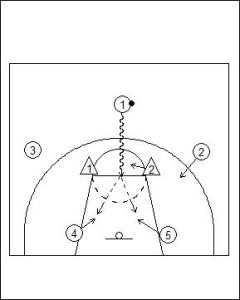The Seven Principles of Success against Zone Defence
Every coach has experienced issues when coaching against a Zone Defence. If as a coach, you have not experienced an issue it is only a matter of time until it happens. Playing against a zone should be no different to facing up against an effective man-to-man defence however, for a number reasons this is not always the case.
Any coach can log onto the internet and find a plethora of options at their fingertips from a quick internet search about zone offences. However, how do you tell the good from the bad? Well Functional Basketball Coaching has put together a list of Seven Principles of Success against a Zone Defence. These principles include:
Defensive Player Movement; for a zone defence to work at its optimum then it must limit the movement as much as possible of the offensive team and the ultimately the ball. The more movement, the more chance there is of a defensive player making a mistake and lead to a complete breakdown of the defence. For this reason, a good or highly effective zone offense will include rotating the ball from one side of the floor to the other and have some measure of continuity.
Move to where there are Gaps in the Zone Defence; every zone defence is designed with a specific outcome in mind. Most zone defences look to take away their opponents strengths and instead replace the scoring opportunities with others that are less desirable for that specific offensive team. Every zone defence has flaws, and most of the time a coach will be able to identify the vacant space in the half court. Therefore, to put it simply ensure your offensive players are aware of this weakness in the formation and look to score through exposing this area. These details are not always evident to players and this can be simply an issue because of lack of communication.

Attack the Seams of the Zone; the gaps between each defensive player is called a seam in the zone. This is where maybe there is an overlapping of responsibilities between the defensive players. For this reason when this area is attacked, the action will often result in two defensive players coming to meet the ball rather than just one. Perform the action a couple of times in succession and your offense will have condensed the zone and exhausted the possible player rotations for the defence. If executed right this will result in one or even two offensive players having the opportunity for a high percentage and uncontested shot.
When a Teammate Catches the Ball Move to Space; a concession for many teams is they will implement a zone offense which does result in a good shot. Nevertheless, the offensive players often become complacent and then do not look to keep playing once the ball is progressing or reaches this position. Once the offense stops moving the defence can recover and overplay help positions. All offensive players until the ball is through the net should look to keep playing and work off the ball to find a receiver spots and good scoring openings.
Catch in a Shooting Stance; good player movement is one thing, another is to have a great offensive strategy, but if the players in the openings are not ready to take advantage of these breaks then they will go unfulfilled. All too often perimeter players will have a play work well in giving them space and time only to have the player not utilise this situation well and still have a highly contested, low percentage shot result which causes not end of frustration to a coach and team mates. Players in set shooting positions should look to catch in a shooting stance for a quick release and the best shot possible.
When the Ball is passed inside Receiver Spots must be filled; when using a zone offense that involves two interior players, the post player who does not receive the entry pass should be looking to dive to the basket or flash to the open space to take advantage of the defence moving towards the ball. Perimeter players should be again always proactive in moving into receiver spots for the close range, high percentage shot from the assist around the keyway.
On a Shot Rebounders must Bump offensive Players towards basket; a zone defence usually provides good rebounding position and balance of the floor around the basket. This is one of the reasons the zone defence is often used by coaches when struggling with the size or athleticism of an opposing offensive team. However because these players are often in ready-made rebounding positions, the offensive players must look to initiate contact similar to when defensive rebounding and bump/bury the defensive players under the rim. This will result in an increased percentage of shots going over the heads of the defensive rebounders and putting the offensive players into stronger offensive rebounding positions. Be careful not to make this contact overly forceful or noticeable or offensive fouls will result.
The Seven Principle of Success against a Zone Defence presented above will help make any zone offense work that little bit more efficiency and effectively. Take some time to imbed these good habits into your team’s zone offense and you will see results instantaneously!







Leave a Reply